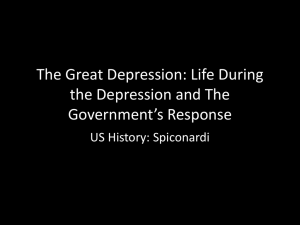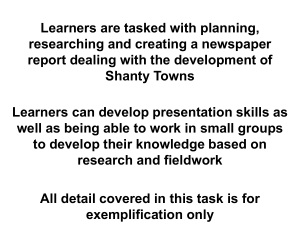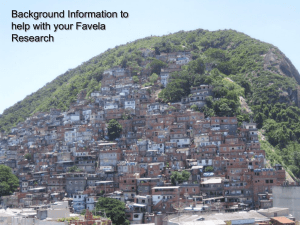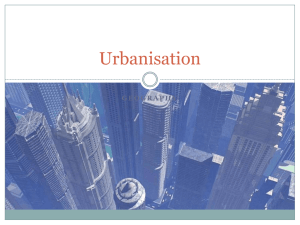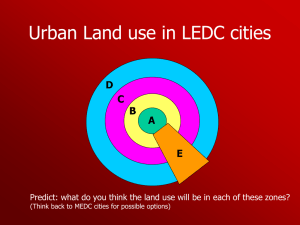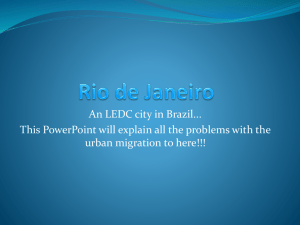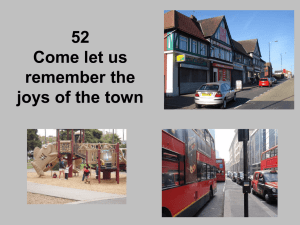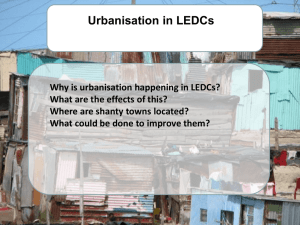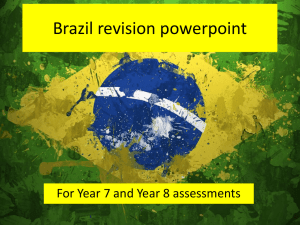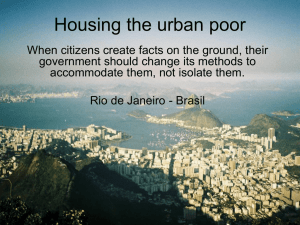Rural-Urban-migration
advertisement
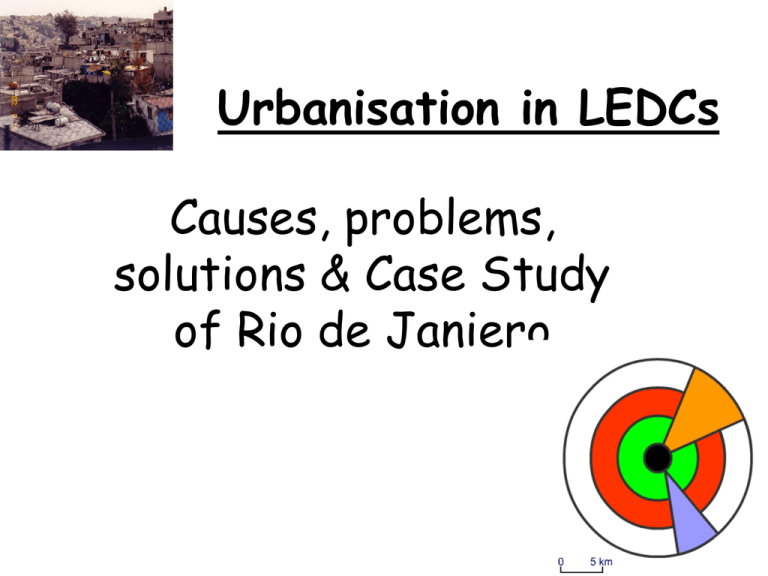
Urbanisation in LEDCs Causes, problems, solutions & Case Study of Rio de Janiero What is urbanisation? The world is becoming mostly urban. % 1950 1990 2001 2025 World 30 45 48 58 MEDC 53 74 76 83 LEDC 17 34 41 56 Study the table. Which parts of the world are experiencing the most rapid growth in their populations? Where are the world’s largest cities? There are 17 megacities in the world – these are cities with a population of over 10 million. These are shown on the map below. The United Nations estimate that by 2015 the number of megacities will have increased to 21! new megacities are shown in orange Describe the distribution of megacities in 2000. How does this compare to 2015? Urbanisation is taking place at a rapid pace in LEDC cities. This is as a result of a process called rural-urban migration. What is rural-urban migration? • Rural-urban migration is the movement of people from the countryside to the city. • This causes three things to happen: Urban growth - towns and cities are expanding, covering a greater area of land. Urbanisation - an increasing proportion of people living in towns and cities. Mega cities - those with over 10 million people. • People are attracted to urban areas because they think that, they will have greater opportunities there. For many, life, is better but some end up in poverty. Rural-urban migration happens as a result of push and pull factors. Where in the world… Imagine you are a migrant in Brazil. Put the following statements in the appropriate circle on the Venn diagram. 1. I have come from here. 2. I will be able to get better medical treatment. 3. I am most likely to end up living here. 4. Other people like me are likely to be living here. 5. I am least likely to get a job here. 6. I am most likely to work the longest hours here. 7. I am likely to be happy here. 8. My family are likely to be here. 9. The living conditions are going to be the best. 10. I am most likely to get a job here. 11. I am most likely to be able to go to school here. 12. I hope to end up living here. A C B Problems faced in LEDC cities as a result of rapid urbanisation 1. Poor electricity and power supplies 2. Pollution 3. Lack of clean water 4. Few employment opportunities 5. Traffic problems 6. Poverty 7. Drugs, gangs and violence 8. Poor education and health provision 9. Poor sewerage systems 10. Poor rubbish collection 11. Lack of shelter Sort the problems caused by urban growth and development of shanty towns into social, environmental & economic. Traffic Congestion as cars/buses/rickshaws/a nimals all share same roads Unemployment as there are few jobs in formal sector. Rural migrants can’t find jobs because they are often illiterate or non-skilled so the informal sector grows. Shanty towns are built on poor quality or unsafe land so are prone to flooding/landslides/fires Poverty High birth rates Wages are low paid and workers are exploited. Sewage on streets leads to water borne disease such as cholera/diarrhoea Air pollution/Smog from car fumes and factories Up to 50% of the population live in Shanty towns High Infant mortality rates Health Problems EG Asthma & Bronchitis caused by pollution Water pollution – rivers/seas used as dustbins Poor quality building materials and a lack of basic amenities eg running water/toilets in shanty towns Shanty towns are illegal Increase in crime Malnutrition Overcrowding Disease spreads quickly because of high density housing. More street children Break up of families Underground water supplies being lost. As shanty towns are built agricultural land/woodland is destroyed. Shanty Towns One problem in LEDC cities is the growth of Shanty Towns. A shanty town is a spontaneous settlement that is often built illegally on unused land along roadsides or on the edge of a city. In Brazil they are called FAVELAS Problems/Characteristics of Shanty Towns HOUSING is often a collection of primitive shacks made from any available material. Most houses lack such basic amenities as electricity, gas, running water and sewerage. No refuse collection. HEALTH lack of clean water, no disposal of human waste and rubbish lead to disease. Can't afford doctors. EDUCATION is limited as there are very few schools. Many, even by the age of 6, are trying to earn some money. TRANSPORT earth tracks that often just fill up with rubbish. Few public transport systems. SOCIAL is under constant threat. The factors listed above can lead to break down of marriages. Increase in crime and ‘street children’. Improving Shanty Towns Although most governments would like to remove shanty towns from their cities, they cannot afford to build the necessary replacement accommodation. Two government-assisted schemes in Brazil aimed at improving the quality of life in the shantytowns are: Low-cost Improvements Existing housing is improved by re-building with cheap, quick and easy to use breezeblocks. A tank of water on the roof collects rainwater. Electricity and sewerage may by added. Most people who live in these will have some sort of employment so that they can pay low rents. Self-help schemes Groups of people are encouraged to help build their new homes. Each group will do basic work such as digging the ditches to take the water and sewerage pipes. The local authority will then provide breezeblocks and roofing tiles, and the group will provide the labour. The advantages of this is that it can be done in stages and create a community spirit. The government puts in basic services such as clean water and sewerage and provides building materials, such as breezeblocks. The families then get together and help build the homes (Some being trained as plumbers, some electricians and so on.) This means that the buildings are relatively cheep, hygienic and creates good community spirit. Case Study - Rio de Janeiro, Brazil Rio de Janeiro is a city located on Brazil's south-east coast. It is one of Brazil's largest settlements with a population of approximately 11.7 million people. The population of Rio de Janeiro has grown for a number of reasons. Natural Increase is one reason for its growth (this is when the birth rate is higher than the death rate). The population has also grown as the result of urbanisation. 65% of urban growth is a result of migration. What are the impacts of rapid urban growth for Rio? • Housing pressures (growth of favelas such as Rocinha. 40% live in Favelas) • Lack of employment means people are looking for other ways to earn money many will work in the informal sector e.g. porters, shoe shiners this is employment for half the city’s work force • Transport problems – congestion and pollution • Sanitation and Health (sewage, waste disposal, disease) • Problems of energy supply • Increased demand for services (schools and Hospitals) • Social problems (crime, Rio murder capital of world) • Urban sprawl • Shanty towns are built on unstable land of poor materials– risk of landslides & fires. Example of a Favela: Rocinha • Rocinha is the largest favela in Brazil. • It is located in the southern zone of the city. • It is built on a steep hillside overlooking the city, just one kilometer from the beach. • It is home to between 60,000 to 150,000 people (though this could be more). Solutions to problems in Rocinha Self-help schemes - Rocinha, Favela Bairro Project 1. The authorities in Rio de Janeiro have taken a number of steps to reduce problems in favelas. 2. They have set up self-help schemes. This is when the local authority provide local residents with the materials needs to construct permanent accommodation. This includes breeze blocks and cement. The local residents provide the labour. The money saved can be spent on providing basic amenities such as electricity and water. Today, almost all the houses in Rocinha are made from concrete and brick. 3. Some buildings are three and four stories tall and almost all houses have basic sanitation, plumbing, and electricity. 4. Compared to simple shanty towns or slums, Rocinha has a better developed infrastructure and hundreds of businesses such as banks, drug stores, bus lines, cable television, including locally based channel TV ROC, and, at one time, even a McDonalds franchise, though it has since closed. What are the sustainable solutions to other problems in Rio? • Forced evictions of squatter settlements – To clear land for formal development • Low cost housing – Very basic breeze block housing constructed. People re-housed in them. City of God • Site and Service – Land is cleared and building plots prepared with water and electricity. • Self Help Scheme – Existing settlements provided with water, sewage and rubbish collection. Building materials provided for residents to upgrade their homes (Favela Barrio Plan) • Rural Development – To reduce rural to urban migration • Increasing policing - to stop new squatter settlement • Raise taxes - on the rich to pay for improving housing for the poor • Local initiatives – such as Afro-Reggae using music and culture to keep kids away from crime and drugs Task – Complete the concept map to help your revision. Differences in land use? LEDC MEDC Exam Question Compare the model of landuse in an LEDC and MEDC city. In cities in both MEDCs and LEDCs there is a CBD usually near the centre of the city. The poorer part of the MEDC city is the inner city and the zone of transition, which are close to the CBD. In an LEDC city the poorest people live in shanty towns (favela’s). Many of these are on the outskirts of the city but others are found near transport routes or where there are unfavourable physical sites such as steep slopes.
